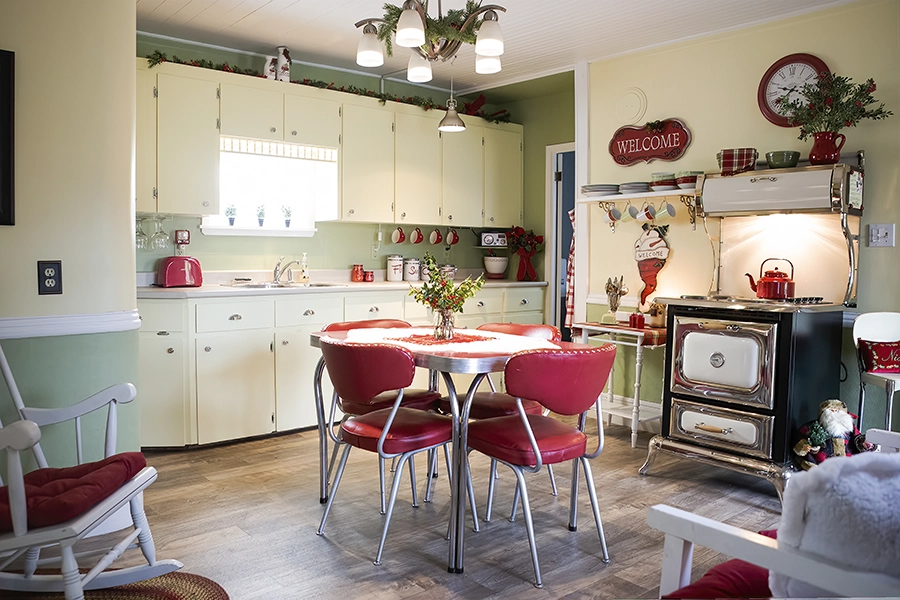“People think it’s easy to build a house,” says Jenipher Ritchie, long-time producer of This Hour Has 22 Minutes and other TV and film productions. “There’s nothing easy about building a house. There are hundreds, if not thousands, of decisions to be made.”
Jenipher and her husband Paul Gidney live in Sandy Cove, Nova Scotia. This small rural village is located midway between Digby and Brier Island on a peninsula that’s commonly referred to as Digby Neck.
Paul and his family have deep roots here. Although Jenipher didn’t have family living permanently in “the cove,” she often visited an aunt who had a summer cottage there. She grew fond of the area.
“Sandy Cove is really a remarkable place,” she says. “There is a huge sense of community here and a huge sense of family. But it’s not about the Internet or your Blackberry. I always say, you either fall in love with Sandy Cove or you don’t understand it.”
When they first got together, Paul was the caretaker of about 50 homes in the village. “People were kind enough to let us stay in their homes while we were looking for a place to buy,” says Jenipher.
Eventually they bought a home on the St. Mary’s Bay side of the village. They spent hours walking through the woods and gardening on Paul’s family property over on the Bay of Fundy side of the village, so they decided to build there.
The couple made lists of what was important and mapped out design ideas. Jenipher kept a “look book” during the project. Anytime she saw pictures of things she liked, she’d clip them out (or print them if online) and put them in a big sketch book.
“We wanted something that would tie in with the community and not stick out like a sore thumb,” she says. “I also wanted to tie in the ocean with the woods, and have the house tie in with nature.”
A friend did some basic computer drawings, they found a construction firm in nearby Clare, and before the close of 2007 Jenipher and Paul were in their new home.
The two-level timber-frame structure has lots of light and expansive views. Looking through the massive windows in the kitchen area upstairs reveals rolling hills and landscaped gardens edged by a forest to the north east. Turning 180 degrees showcases a limitless expanse of sky and ocean, a front-row seat to the Bay of Fundy.
The home’s interior parallels those natural surroundings, with wooden beams, artwork, and furniture echoing both land and sea in their simplicity and beauty.
Initially, the couple lived in the upstairs portion of the home which included their bedroom, bathroom, kitchen, and living area. They used the lower section as a combination barn/garage and for storage.
Both ends of the bottom level had garage doors with windows, so not only was it easy to move equipment in and out, the arrangement also provided bucolic views from either end, just like on the upper level.
But, as time went on, Jenipher realized that although she liked the home, it wasn’t quite right. It lacked space for company and she wondered if building a guest house would be the answer.
Enter Lisa Tondino from Houdinidesign Architects, based in Canning. “We spent a lot of time in the schematic design phase, thinking through and distilling the most simple ideas and solutions,” Lisa says.
They soon realized that a new structure wasn’t required. By turning the downstairs into liveable space, they could make internal changes that would double the living space from 1,500 to 3,000 square feet.
Phase one involved changing the lower level into a master bedroom, plus adding a bathroom and a laundry area. The challenge was keeping the central area open, which would create a gallery space to showcase the homeowners’ art collection. It would also allow light and airflow from both ends of the structure.
The second phase, reconfiguring the upper level, posed a different challenge: how to create space for guests, along with a full bathroom, and storage to house the fridge and kitchen appliances.
“We took a precedent from Charles Moore’s Room Within a Room,” says Lisa, who collaborated with designers Judy Obersi and Alexandra Bolen on the project. Moore was an innovative American architect who often doubled the use of space by cleverly (and unobtrusively) inserting a second room within an existing room.
Here’s how Lisa and her team applied the principle: inside the wall between the kitchen and the living room is now a three-by six-metre protrusion housing a bathroom. But here’s where it gets interesting: an outside wall, 0.6-metres from the wall surrounding the bathroom on three sides, now houses a Murphy bed and storage for everything else. Part of this walled space also includes the bathroom sink.
Finished in 2015, the new configuration not only provides more solutions and flexibility for Jenipher and Paul, it still offers an uninterrupted view from both ends of the upper level. “[It] respects the existing structural order and detailed the connection to the old and the new, while celebrating their differences,” Lisa says. “And an open-air staircase creates a visual connectivity between the two floors, enabling Jenipher and Paul to inhabit the entire house.”
Jenipher is thrilled with the results, and has advice for others who are thinking about renovating. “Spend a couple of years researching,” she says. “The things you think are not expensive are the things that can be the most expensive. And, as you collect information, plan for three options.”
For example, pick three faucets with three price ranges. Apply this to everything, as you can count on going over budget and may have to substitute something less expensive than your first choice. “And you need at least a 10- to 15-per-cent contingency,” she adds.
Jenipher admits she didn’t do enough research the first time around. “I put in single-pane wooden windows downstairs that looked very pretty, but they covered in ice every winter. When I did replace them, I should have included windows that open.”
Other missteps back then included not putting electrical plugs in the right places, and having some structural beams in the wrong place. The latter affected the height of the windows, which she thought would be higher than they are.
Also, workers had originally poured the concrete floor too thick that housed in-floor heating; during the renovations, drilling through the floor to add plumbing and electrical was nerve-wracking. “A mistake could have been very costly,” Jenipher recalls.
Jenipher says that her first building experience was fun, but she regrets not hiring an architect from the get-go. “There’s nothing cheap about renovating and nothing cheap about architects,” she says. “There are many different phases to building a house from concepts to design, construction drawings, and supervising the construction. Every phase comes with a cost. It’s important to understand that up front.”
For her, the payoff is getting the house she wanted in the end. “And they take responsibility if something goes wrong,” she adds. She recommends monitoring the budget on a weekly basis. “If you are 50 per cent through the project and you’ve spent 75 per cent of the money, you’re in trouble.”
She also recommends using a 3D model. It’s an added expense, but it gives a practical sense of how things will look and feel.
“What I love the most about our house is that anywhere I sit I can look outside,” Jenipher says with a smile. “The views of the Bay of Fundy are stunning and the sunset is incredible. My father always said, ‘I knew you would end up down here.’”









.jpg)






















